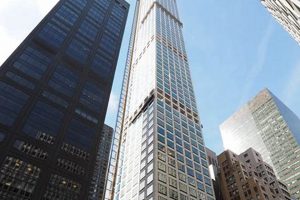A skyscraper is a continuously habitable high-rise building that has over 40 floors and is taller than 150 meters (492 feet). The term “skyscraper” is often used to refer to any high-rise building, but it is most commonly applied to buildings that are at least 100 stories tall.
Skyscrapers are important because they can accommodate a large number of people in a relatively small area. This can be beneficial in cities where land is scarce and expensive. Skyscrapers can also be used to create iconic landmarks and to boost a city’s skyline. Historically, the construction of skyscrapers has been driven by the desire to create taller and more impressive buildings.
There are many different types of skyscrapers, including residential, commercial, and mixed-use buildings. Skyscrapers can also vary greatly in terms of their architectural style. Some of the most famous skyscrapers in the world include the Empire State Building, the Burj Khalifa, and the One World Trade Center.
1. Tall – Skyscrapers are some of the tallest structures in the world.
The height of a skyscraper is one of its defining characteristics. Skyscrapers are designed to be tall in order to maximize the amount of space that they can provide. This is important in cities where land is scarce and expensive. Skyscrapers can also be used to create iconic landmarks and to boost a city’s skyline.
The height of a skyscraper is also a testament to the engineering and architectural skills of the people who designed and built it. Skyscrapers are complex structures that require careful planning and execution. The tallest skyscrapers in the world are marvels of engineering and architectural achievement.
The height of a skyscraper can also have a significant impact on the people who live and work in it. Tall skyscrapers can offer stunning views of the surrounding city. They can also be more energy efficient than shorter buildings, as they can take advantage of natural ventilation and sunlight. However, tall skyscrapers can also be more challenging to evacuate in the event of a fire or other emergency.
2. Dense – Skyscrapers can accommodate a large number of people in a relatively small area.
The density of a skyscraper is one of its key characteristics. Skyscrapers are designed to be dense in order to maximize the amount of space that they can provide. This is important in cities where land is scarce and expensive. Skyscrapers can also be used to create iconic landmarks and to boost a city’s skyline.
The density of a skyscraper is also a testament to the engineering and architectural skills of the people who designed and built it. Skyscrapers are complex structures that require careful planning and execution. The tallest skyscrapers in the world are marvels of engineering and architectural achievement.
The density of a skyscraper can also have a significant impact on the people who live and work in it. Dense skyscrapers can offer a variety of amenities and services to their residents and workers. They can also be more energy efficient than less dense buildings, as they can take advantage of natural ventilation and sunlight. However, dense skyscrapers can also be more challenging to evacuate in the event of a fire or other emergency.
In conclusion, the density of a skyscraper is an important factor to consider when designing and building these structures. Skyscrapers can be used to accommodate a large number of people in a relatively small area, but it is important to carefully consider the impact that this density will have on the people who live and work in the building.
3. Landmark – Skyscrapers can be iconic landmarks that define a city's skyline.
Skyscrapers are often associated with iconic landmarks that define a city’s skyline. This is because skyscrapers are large, impressive structures that can be seen from a distance. They can also be used to create unique and distinctive skylines that are easily recognizable. For example, the Empire State Building is an iconic landmark that defines the New York City skyline. The Burj Khalifa is an iconic landmark that defines the Dubai skyline. The Shanghai Tower is an iconic landmark that defines the Shanghai skyline.
- Symbolism – Skyscrapers can be symbols of a city’s power and prosperity. For example, the Empire State Building is often seen as a symbol of New York City’s financial power. The Burj Khalifa is often seen as a symbol of Dubai’s economic power. The Shanghai Tower is often seen as a symbol of Shanghai’s economic power.
- Identity – Skyscrapers can help to create a city’s identity. For example, the Golden Gate Bridge is an iconic landmark that is closely associated with San Francisco. The Sydney Opera House is an iconic landmark that is closely associated with Sydney. The Petronas Towers are iconic landmarks that are closely associated with Kuala Lumpur.
- Tourism – Skyscrapers can be major tourist attractions. For example, the Empire State Building is one of the most popular tourist attractions in New York City. The Burj Khalifa is one of the most popular tourist attractions in Dubai. The Shanghai Tower is one of the most popular tourist attractions in Shanghai.
- Community – Skyscrapers can be a source of pride for a city’s residents. For example, the Empire State Building is a source of pride for New Yorkers. The Burj Khalifa is a source of pride for Dubai residents. The Shanghai Tower is a source of pride for Shanghai residents.
In conclusion, skyscrapers can be iconic landmarks that define a city’s skyline. They can also be symbols of a city’s power, prosperity, and identity. Skyscrapers can be major tourist attractions and a source of pride for a city’s residents.
4. Functional – Skyscrapers can serve a variety of functions, including residential, commercial, and mixed-use.
Skyscrapers are not just tall buildings; they are also highly functional structures that can serve a variety of purposes. The three main types of skyscrapers are residential, commercial, and mixed-use.
- Residential skyscrapers are designed for people to live in. They typically have apartments or condos on each floor. Residential skyscrapers can be found in both urban and suburban areas.
- Commercial skyscrapers are designed for businesses to operate in. They typically have offices on each floor. Commercial skyscrapers are usually found in urban areas.
- Mixed-use skyscrapers are a combination of residential and commercial space. They typically have apartments or condos on the lower floors and offices on the upper floors. Mixed-use skyscrapers are becoming increasingly popular in urban areas.
The functional diversity of skyscrapers is one of the things that makes them so valuable. Skyscrapers can provide a variety of living and working spaces in a single building. This can make it easier for people to live and work in the same area, which can reduce traffic and pollution. Skyscrapers can also be used to create more sustainable communities by incorporating green features and energy-efficient design.
In conclusion, the functional diversity of skyscrapers is an important aspect of their design and use. Skyscrapers can serve a variety of purposes, from providing housing to accommodating businesses. This functional diversity makes skyscrapers valuable assets to cities and communities around the world.
5. Historical – Skyscrapers have a long and fascinating history, dating back to the late 19th century.
The history of skyscrapers is closely intertwined with the development of modern cities. The first skyscrapers were built in the late 19th century in Chicago and New York City. These early skyscrapers were made of steel and iron and were typically 10-15 stories tall. Over time, skyscrapers became taller and more complex, and they began to be built in cities all over the world.
- Technological advancements – The development of new technologies, such as the elevator and the steel frame, made it possible to build taller and more complex skyscrapers. These technologies allowed architects and engineers to design buildings that were both functional and aesthetically pleasing.
- Urban growth – The rapid growth of cities in the late 19th and early 20th centuries led to a demand for more housing and office space. Skyscrapers were a way to meet this demand, as they could accommodate a large number of people in a relatively small area.
- Economic factors – The construction of skyscrapers was also driven by economic factors. Skyscrapers were seen as a way to attract businesses and investment to a city. They could also be used to generate revenue, as they could be rented out to tenants.
- Cultural factors – Skyscrapers have also been influenced by cultural factors. For example, the Art Deco style of architecture was popular in the 1920s and 1930s, and many skyscrapers built during this period reflect this style.
The history of skyscrapers is a fascinating one, and it is still being written today. Skyscrapers continue to be built in cities all over the world, and they continue to evolve in terms of design, function, and construction. Skyscrapers are a testament to the human spirit of innovation and creativity, and they are a vital part of the modern cityscape.
6. Cultural – Skyscrapers can be Ausdruck of a city's culture and values.
Skyscrapers are not just tall buildings; they are also cultural icons that can reflect the values and aspirations of a city. For example, the Empire State Building is a symbol of New York City’s financial power and ambition. The Burj Khalifa is a symbol of Dubai’s economic power and ambition. The Shanghai Tower is a symbol of Shanghai’s economic power and ambition.
Skyscrapers can also be used to express a city’s cultural identity. For example, the Golden Gate Bridge is an iconic landmark that is closely associated with San Francisco. The Sydney Opera House is an iconic landmark that is closely associated with Sydney. The Petronas Towers are iconic landmarks that are closely associated with Kuala Lumpur.
The cultural significance of skyscrapers is an important aspect of their design and use. Skyscrapers can be used to create a sense of place and identity for a city. They can also be used to promote a city’s culture and values to the world.
In conclusion, skyscrapers are not just tall buildings; they are also cultural icons that can reflect the values and aspirations of a city. Skyscrapers can be used to create a sense of place and identity for a city. They can also be used to promote a city’s culture and values to the world.
7. Architectural – Skyscrapers can be architectural marvels, showcasing innovative design and engineering.
Skyscrapers are architectural marvels that showcase innovative design and engineering. They are feats of human ingenuity and creativity, pushing the boundaries of what is possible in terms of height, form, and function. The architectural design of skyscrapers is a complex and challenging process, requiring a deep understanding of structural engineering, materials science, and aesthetics. Architects and engineers must work together closely to create skyscrapers that are both safe and beautiful.
Skyscrapers are often used to express a city’s cultural identity and values. For example, the Empire State Building is a symbol of New York City’s financial power and ambition. The Burj Khalifa is a symbol of Dubai’s economic power and ambition. The Shanghai Tower is a symbol of Shanghai’s economic power and ambition.
The architectural significance of skyscrapers is an important aspect of their design and use. Skyscrapers can be used to create a sense of place and identity for a city. They can also be used to promote a city’s culture and values to the world.
In conclusion, skyscrapers are architectural marvels that showcase innovative design and engineering. They are feats of human ingenuity and creativity, pushing the boundaries of what is possible in terms of height, form, and function. The architectural significance of skyscrapers is an important aspect of their design and use. Skyscrapers can be used to create a sense of place and identity for a city. They can also be used to promote a city’s culture and values to the world.
FAQs About Skyscrapers
Skyscrapers are awe-inspiring structures that have reshaped the skylines of cities worldwide. They stand as te
staments to human ingenuity and architectural prowess. However, there are many common misconceptions and questions surrounding these towering giants. This FAQ section aims to provide concise and informative answers to some of the most frequently asked questions about skyscrapers.
Question 1: What exactly defines a skyscraper?
A skyscraper is a continuously habitable high-rise building that typically exceeds 150 meters (490 feet) in height and has over 40 floors. However, there is no universally accepted definition, and the term “skyscraper” is often applied to buildings that are at least 100 stories tall.
Question 2: What is the purpose of building skyscrapers?
Skyscrapers serve various purposes and offer significant advantages. They allow for efficient land use in densely populated urban areas, providing ample space for residential, commercial, and mixed-use developments. Additionally, skyscrapers can enhance a city’s skyline and serve as iconic landmarks.
Question 3: Are skyscrapers safe and stable during extreme weather conditions?
Modern skyscrapers are designed with advanced engineering techniques and materials to withstand high winds, earthquakes, and other natural disasters. They employ sophisticated structural systems, such as reinforced concrete cores and exterior steel frames, to ensure stability and resilience against lateral forces. Regular maintenance and ongoing advancements in construction technology further contribute to the safety of skyscrapers.
Question 4: What are the key elements that contribute to the overall design of a skyscraper?
The design of a skyscraper involves meticulous planning and consideration of various factors. Architects and engineers collaborate to optimize the building’s height, shape, and structural integrity. Factors such as wind resistance, seismic activity, and the efficient use of space are carefully analyzed to create a functional and aesthetically pleasing structure.
Question 5: How do skyscrapers impact the surrounding environment and urban infrastructure?
Skyscrapers have both positive and negative environmental implications. They can promote efficient energy use by incorporating sustainable design features, such as energy-saving lighting systems and rainwater harvesting. However, the construction and operation of skyscrapers can also contribute to increased energy consumption and urban heat island effects. Careful urban planning and the integration of green building practices can mitigate these potential drawbacks.
Question 6: What are the future trends and innovations in skyscraper design and construction?
The future of skyscrapers holds exciting possibilities. Emerging technologies and innovative materials are constantly pushing the boundaries of design and construction. Sustainable practices, such as the use of renewable energy sources and green facades, are becoming increasingly incorporated. Additionally, advancements in modular construction techniques and prefabrication are streamlining the building process, allowing for faster and more efficient construction.
In conclusion, skyscrapers are remarkable feats of engineering that continue to shape our cities and push the limits of architectural possibilities. Understanding the design, purpose, and impact of skyscrapers provides a deeper appreciation for these iconic structures that define skylines worldwide.
To learn more about skyscrapers, explore our comprehensive article that delves into their history, architectural significance, and impact on society.
Tips on Understanding Skyscrapers
Understanding skyscrapers requires a multifaceted approach. Here are some tips to enhance your knowledge and appreciation of these architectural marvels:
Tip 1: Explore the History of Skyscrapers
Delve into the historical evolution of skyscrapers. Learn about the pioneering architects, engineering advancements, and cultural influences that have shaped their design and construction over time.
Tip 2: Study the Architectural Elements
Familiarize yourself with the key architectural elements of skyscrapers, including their structural systems, exterior materials, and interior layouts. Understand how these elements contribute to the stability, functionality, and aesthetic appeal of these buildings.
Tip 3: Analyze the Engineering Marvels
Appreciate the engineering prowess behind skyscrapers. Learn about the innovative structural designs, wind-resistant technologies, and seismic safety measures that ensure their resilience and longevity.
Tip 4: Consider the Urban Impact
Examine the impact of skyscrapers on the urban environment. Understand how they shape skylines, create dense urban cores, and influence transportation and infrastructure planning.
Tip 5: Explore Sustainable Practices
Investigate the sustainable design features incorporated into modern skyscrapers. Learn about green building technologies, energy-efficient systems, and rainwater harvesting techniques that promote environmental responsibility in high-rise construction.
By following these tips, you can gain a deeper understanding and appreciation for skyscrapers, their architectural significance, and their impact on our cities and skylines.
To further your knowledge, explore our comprehensive article on skyscrapers, which delves into their history, design, and societal implications.
Conclusion
Skyscrapers, with their towering heights and architectural grandeur, have become iconic symbols of modern cities. They represent not only feats of engineering but also testaments to human ambition and creativity. Throughout this article, we have explored the multifaceted nature of skyscrapers, examining their historical evolution, architectural significance, cultural impact, and sustainable practices.
Skyscrapers have reshaped our urban landscapes, creating dense and vibrant city centers. They have pushed the boundaries of design and engineering, showcasing innovative structural systems and sustainable technologies. As we continue to build upwards, it is essential that we consider the broader implications of skyscrapers on our cities and environment. By embracing sustainable practices and fostering a collaborative approach between architects, engineers, and urban planners, we can create skyscrapers that are not only awe-inspiring but also responsible and resilient.







